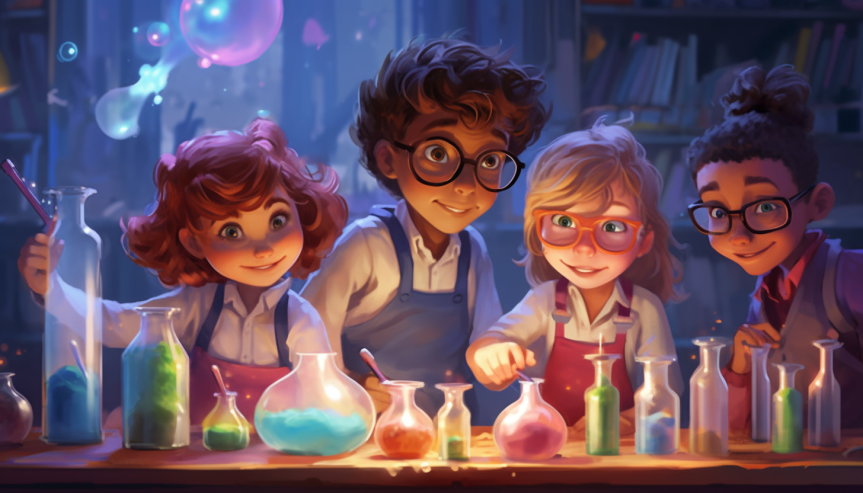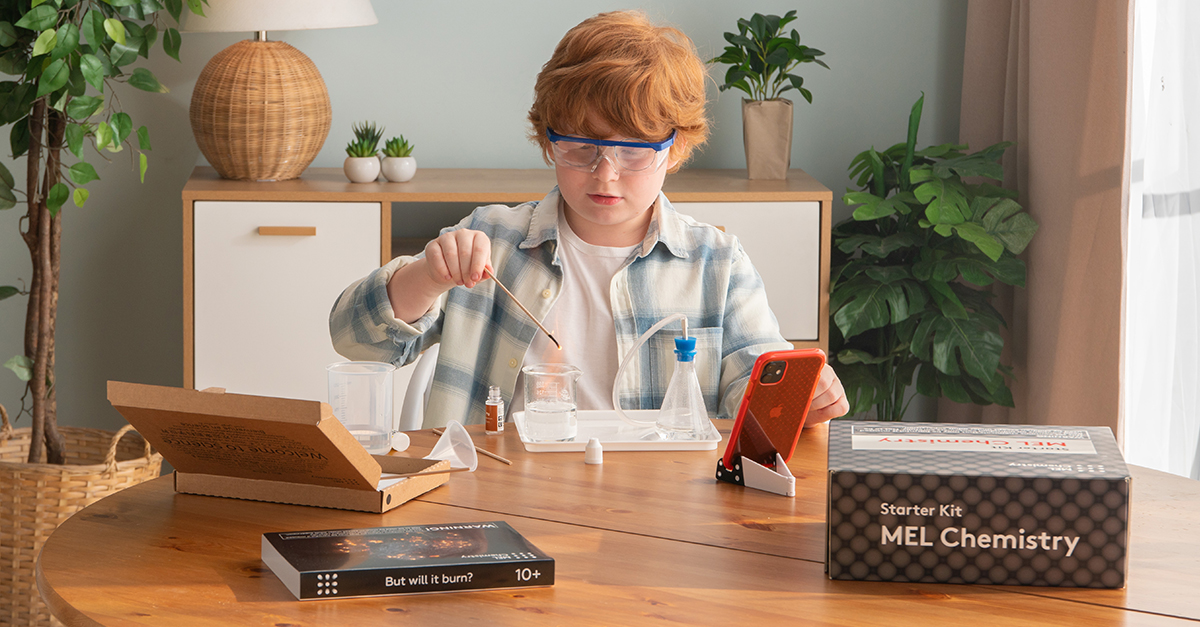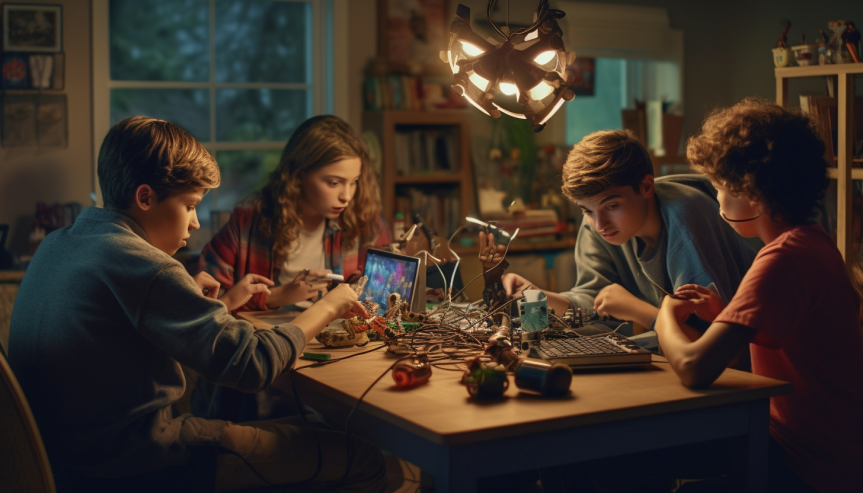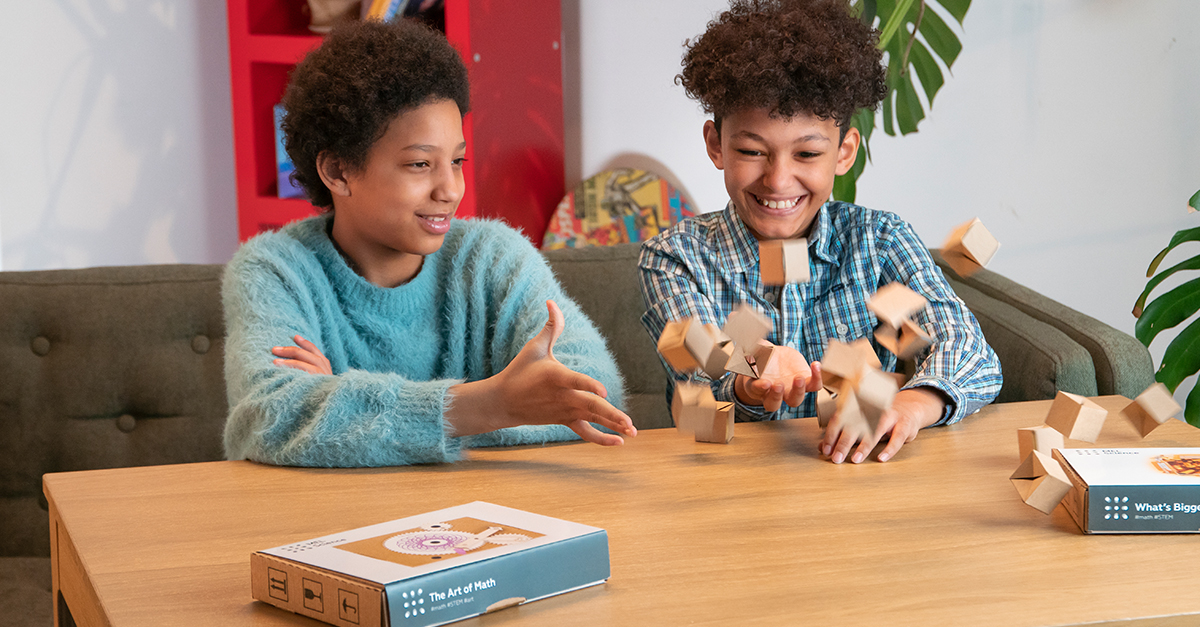The Ultimate Guide to Kids Chemistry - Fun Experiments & Activities for Elementary Schoolers
Who said chemistry can’t be fun and accessible for kids? With engaging experiments and interactive activities, children can discover the fascinating world of chemical reactions and processes.

Who said chemistry can’t be fun and accessible for kids? With engaging experiments and interactive activities, children can discover the fascinating world of chemical reactions and processes. Let’s dive into the ultimate guide to kids chemistry, where we’ll explore various hands-on experiments, online resources, and recommended books to spark their curiosity and love for chemistry!
Key Takeaways
- Explore chemistry with exciting experiments like making a baking soda volcano and fizzy lemonade!
- Create captivating displays of swirling colors with Magic Milk & make homemade slime for an educational experience.
- Discover two fantastic books to spark curiosity & explore the periodic table - The Elements Book by DK & Chemistry: Getting a Big Reaction!
Fun Chemistry Experiments for Kids

Chemistry experiments offer an engaging platform for kids to delve into the core science of chemistry. Through hands-on activities, children can witness chemical reactions, acids and bases, and polymers come to life. Imagine the excitement of creating a baking soda volcano, watching borax crystals form, or mixing colors in a magic milk experiment! These fun chemistry experiments not only captivate young minds, but also help them develop problem-solving skills, critical thinking, and creativity.
So let’s delve into a few cool chemistry experiments that will undoubtedly spark your child’s interest and foster a love for science. Up next, we’ll examine:
- Fizzy lemonade
- Magic milk
- Homemade slime
- Invisible ink messages
All intriguing activities for budding scientists in major sciences and other major sciences!
Fizzy Lemonade
Fizzy lemonade is a fantastic way to teach kids about chemical reactions while enjoying a tasty treat. By mixing sodium bicarbonate, also known as baking soda, citric acid, and sugar, we create a delightful fizzy beverage. The chemical reaction between baking soda and citric acid produces carbon dioxide gas, which gives lemonade its fizz.
As kids prepare and enjoy their fizzy lemonade, they’ll learn about chemical reactions and carbon dioxide production in an exciting, hands-on manner. This experiment is not only enjoyable, but also secure and straightforward to execute at home or in the classroom. It’s perfect for younger kids who are starting to explore chemistry, as well as older children who want to dive deeper into understanding the science behind everyday reactions.
Magic Milk
Magic milk serves as another captivating experiment intertwining art and science. By mixing milk, food coloring, and dish soap, we create a mesmerizing display of swirling colors. As the dish soap is added to the milk, it breaks down the fat molecules, causing the food coloring to radiate out and mix. The result is a stunning, colorful spectacle that will leave kids in awe.
Not only does magic milk allow children to discover the reaction between milk and dish soap, but it also encourages them to explore color mixing and the artistic side of chemistry. This exciting experiment is perfect for younger kids who are just beginning to experience the world of chemical reactions and the beauty that lies within.
Homemade Slime
Kids love playing with slime, and making it at home is an excellent way to teach them about polymers and non-Newtonian fluids. By combining simple ingredients like glue, borax, and water, kids can create their own homemade slime that is not only entertaining but also educational. The glue in the slime is a polymer, and when mixed with borax or liquid starch, it forms a non-Newtonian fluid, which behaves differently than a regular liquid.
The homemade slime experiment allows kids to experiment with different amounts of glue and borax to achieve various consistencies. They can also add different colors of food coloring or glitter to make their slime more interesting and personalized. This fun chemistry experiment is perfect for children of all ages, providing an engaging and hands-on learning experience.
Invisible Ink Messages
Invisible ink messages are a thrilling way to teach kids about oxidation and secret messages. Using lemon juice and heat, children can create their own invisible ink and reveal it using a heat source. The steps to create and reveal the message are as follows:
- Squeeze fresh lemon juice into a small bowl.
- Use a cotton swab or paintbrush to write a message on a piece of paper using the lemon juice.
- Allow the lemon juice to dry completely.
- To reveal the message, hold the paper close to a heat source, such as a light bulb or candle flame.
- As the lemon juice is heated, it oxidizes and turns brown, making the message visible.
This science experiment not only fascinates children, but also demonstrates important chemical processes, such as the showcased reaction, in an engaging way.
Creating invisible ink messages is an excellent activity for kids who are interested in chemistry and want to explore the world of secret codes and messages. It’s a fun and educational experiment that kids of all ages can enjoy, sparking their curiosity and love for chemistry.
Chemistry Sets & Subscriptions for Kids

Beyond singular experiments, chemistry sets and subscriptions offer a holistic and intriguing approach for kids to explore the realm of chemistry. These kits offer:
- Hands-on experiments
- Learning materials
- Help children understand the basics of chemistry
- Develop problem-solving skills
- Foster critical thinking
- Encourage creativity
An example of such a chemistry set is the MEL Science Chemistry Kits, which we’ll delve into in the following section.
MEL Science Chemistry Kits
MEL Science Chemistry Kits are educational kits designed to help children discover and explore chemistry through hands-on experiments. Each kit includes:
- Materials and instructions for conducting various experiments
- Opportunities to uncover different chemical reactions and concepts
- A fun and engaging learning experience The kits are suitable for elementary schoolers and provide a safe and interactive way to learn about chemistry.
These chemistry kits offer a wide range of experiments, from making a lava lamp to creating a rainbow in a jar, and even replicating a baking soda volcano. By providing monthly subscriptions with engaging experiments, detailed instructions, and educational materials, MEL Science Chemistry Kits inspire children to dive deeper into the world of chemistry and foster a love for science.
Online Resources for Learning Chemistry

The internet offers a wealth of online resources for learning chemistry, including:
- Interactive periodic tables
- Engaging video lessons
- Virtual labs and simulations
- Online textbooks and study guides
- Chemistry games and quizzes
These resources provide a convenient and accessible way for kids to explore the world of chemistry, the central science, at their own pace, making it easier for them to understand complex concepts and develop a strong foundation in the subject.
Next, we’ll examine popular online resources for learning chemistry, which include interactive periodic tables, Bill Nye the Science Guy videos, and Khan Academy chemistry lessons.
Interactive Periodic Table
Interactive periodic tables provide a fun and engaging way for kids to learn about elements and their properties. These digital tools allow users to:
- Explore and interact with the elements in various ways, such as clicking on an element to view its properties
- Search for specific elements
- Access additional information and resources related to each element
Not only do interactive periodic tables help kids learn about the elements in a more engaging and enjoyable manner, but they also allow them to develop a deeper understanding of the periodic table’s structure and organization. With a wealth of information and interactive features at their fingertips, kids can truly immerse themselves in the world of chemistry and become more familiar with the elements that make up our world.
Bill Nye the Science Guy Videos
Bill Nye the Science Guy videos offer entertaining and educational chemistry lessons for kids, covering a wide range of topics. With his charismatic personality and passion for science, Bill Nye captivates young audiences and makes learning about chemistry fun and engaging. Each video explores a specific scientific concept through amazing experiments, demonstrations, and explanations, making complex ideas more accessible to children.
These videos are an excellent resource for kids who want to learn more about chemistry in a fun and engaging way. With a variety of topics covered, from chemical reactions to the properties of elements, Bill Nye the Science Guy videos provide an entertaining and informative introduction to the world of chemistry.
Khan Academy Chemistry Lessons
Khan Academy provides comprehensive chemistry lessons for kids, featuring easy-to-understand explanations and interactive exercises. Covering a wide range of topics, from atomic structure to chemical reactions and stoichiometry, Khan Academy offers an extensive library of educational resources designed to help students of all ages master the fundamentals of chemistry.
These chemistry lessons are accessible to learners of all ages and skill levels, making it an excellent resource for kids who want to delve deeper into the subject. With video tutorials, practice exercises, and quizzes, Khan Academy provides a well-rounded and engaging learning experience that encourages children to explore the world of chemistry and develop a strong foundation in the subject.
Hands-On Chemistry Activities for Younger Kids

While many chemistry experiments and resources are suitable for older kids, it’s particularly beneficial to engage younger children in hands-on activities tailored to their age group. These activities help them develop a love for chemistry from an early age and lay the foundation for more advanced learning in the future.
Moving forward, we’ll journey through some hands-on chemistry activities designed specifically for younger kids, like color-changing flowers, ice cube painting, and homemade play dough, all of which can be integrated into everyday life as engaging lesson plans.
Color Changing Flowers
Color-changing flowers are an exciting way to teach kids about capillary action and color mixing. By placing white flowers in water with food coloring, they can observe how the flower petals change color as the colored water is absorbed. The science behind this fascinating phenomenon is capillary action, which is the movement of liquid through a porous material.
This experiment not only sparks children’s curiosity and interest in chemistry, but also allows them to:
- Explore color mixing
- Explore the properties of different materials
- Experiment with different types of food coloring and observe the effects on the flower petals
This further deepens their understanding of color mixing and capillary action.
Ice Cube Painting
Ice cube painting is a unique activity that combines art and science, allowing kids to explore color mixing and the properties of water as it changes states. By creating ice cube paints with water and food coloring, children can paint with the melting ice cubes and observe how the colors mix and blend on the paper or canvas.
Not only is this activity a fun and creative way for kids to learn about color mixing, but it also teaches them about the properties of water as it transitions from a solid to a liquid state. Ice cube painting is an engaging and hands-on chemistry activity that younger kids will love, sparking their curiosity and interest in the subject.
Homemade Playdough
Making homemade play dough is a fun and educational activity that teaches kids about chemical reactions and the properties of different materials. Using simple kitchen ingredients like:
- flour
- salt
- cream of tartar
- vegetable oil
Children can create their own play dough while learning about the chemical reaction that occurs when these ingredients are mixed.
Not only is homemade play dough an entertaining activity for younger kids, but it also provides an opportunity for them to explore the properties of different materials and learn about chemical reactions in a hands-on manner. With endless possibilities for customization and play, homemade play dough is a fantastic chemistry activity for children of all ages.
Recommended Chemistry Books for Kids

In addition to hands-on experiments and online resources, there are many excellent chemistry books available for kids that provide engaging and informative content on various chemistry concepts. These books can help children solidify their understanding of the subject and inspire them to explore further.
Next, we’ll review two highly acclaimed chemistry books for kids: The Elements Book by DK and Chemistry: Getting a Big Reaction! by Dan Green.
The Elements Book by DK
The Elements Book by DK is a visually appealing and informative guide to the periodic table, perfect for kids interested in chemistry. With stunning photographs and illustrations, this comprehensive guide provides detailed information about each element, including:
- Atomic number
- Symbol
- Atomic weight
- Properties
Making it an invaluable resource for chemistry students, called chemists, and anyone interested in chemistry.
Not only is The Elements Book by DK a valuable educational tool, but its captivating visuals also make it an enjoyable read for kids, inspiring them to learn more about the elements and their characteristics. This book is an excellent addition to any young chemist’s library, sparking curiosity and love for the subject.
Chemistry: Getting a Big Reaction! by Dan Green
Chemistry: Getting a Big Reaction! Dan Green is another fantastic book that provides an engaging and accessible introduction to chemistry concepts for kids. With fun illustrations and easy-to-understand explanations, this book covers a wide range of topics, from atomic structure to chemical reactions, making it a perfect resource for young learners.
Kids will undoubtedly enjoy the entertaining approach to chemistry presented in this book, making it an excellent starting point for children who are new to the subject. By breaking down complex ideas into digestible and engaging content, Chemistry: Getting a Big Reaction! Not only educates but also captivates young readers, fostering a love for chemistry and encouraging further exploration.
Summary
In conclusion, there are numerous fun chemistry experiments, activities, and resources available to engage kids in the fascinating world of chemistry. From fizzy lemonade and magic milk to homemade slime and invisible ink messages, hands-on experiments provide an excellent opportunity for children to learn and explore chemistry concepts. Online resources like interactive periodic tables and engaging video lessons, as well as recommended chemistry books, further support their learning journey. By engaging kids in these exciting activities and resources, we can inspire a new generation of budding chemists who will carry their love for chemistry throughout their lives.
Frequently Asked Questions
What is chemistry explained to kids?
Chemistry is the field of science that studies the properties of matter and how it interacts with energy. It’s a physical science connected to physics, and looks at how matter changes and transforms to create the universe we know.
Through chemistry, we learn about the make-up of everything and how they behave. Exciting!
At what age do kids learn chemistry?
At around 6th grade, kids can start to learn the basics of chemistry, such as the periodic table of elements.
By 10th grade in high school, they will be exploring all the fundamentals of chemistry in more detail.
What are some chemistry experiments for kids?
Let your kids explore chemistry with exciting experiments like Milk Painting, Citrus Battery, Elephant Toothpaste, Plastic Milk and Curds & Whey Experiment, Chemistry clock, Blow Balloons with yeast and sugar, Lemon Volcano, and the Colorful Cabbage Juice Science Experiment and Acid Base Experiment with Cabbage!
These experiments are fun and educational, and can help your kids learn about the basics of chemistry. They can explore the different reactions that occur when different substances are combined, and learn about the properties of acids and bases. They can also learn about the different states of matter and how they interact with each other. With these experiments, your kids can have a great time while learning about chemistry.
What are the 5 types of chemical reactions for kids?
Learning about chemical reactions has never been easier for kids! There are five basic categories of reactions they need to know: synthesis, decomposition, single replacement, double replacement and combustion.
A single displacement reaction is a type of single replacement reaction where one element is replaced by another in a compound. With this knowledge, students will be well on their way to mastering chemical reactions!
Are chemistry sets and subscriptions safe for kids to use?
Yes, chemistry sets and subscriptions are designed with safety in mind, offering interactive experiences for kids through hands-on experiments and learning materials.

